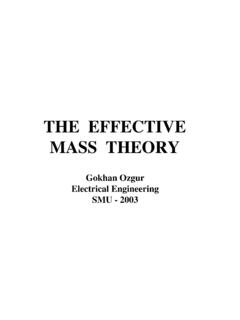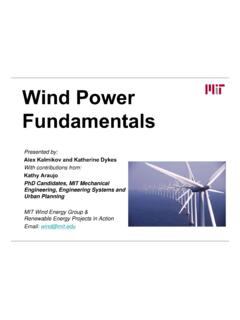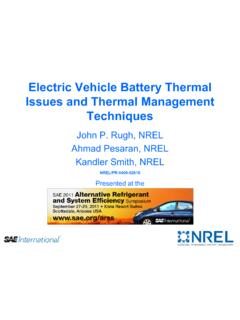Transcription of 6.007 Lecture 11: Magnetic circuits and transformers
1 Magnetic circuits Outline Ampere s Law Revisited Review of Last Time: Magnetic Materials Magnetic circuits Examples 1 electric Fields Magnetic Fields dA= oE dVBSV dA=0S=QenclosedGAUSS GAUSS FARADAY AMPERE d E dl= B dAH dlCdt( S ) C = dJ dA+ E dAdtd SSemf=v=dt2 Ampere s Law Revisited In the case of the Magnetic field we can see that our old Ampere s law can not be the whole story. Here is an example in which current does not gives rise to the Magnetic field: Consider the case of charging up a capacitor C which is connected to very long wires. The charging current is I. From the symmetry it is easy to see that an application of Ampere s law will produce B fields which go in circles around the wire and whose magnitude is B(r) = oI/(2 r). But there is no charge flow in the gap across the capacitor plates and according to Ampere s law the B field in the plane parallel to the capacitor plates and going through the capacitor gap should be zero!
2 This seems unphysical. Side View B B B B=0??IIII3 Ampere s Law Revisited (cont.) If instead we drew the Amperian surface as sketched below, we would have concluded that B in non-zero ! BBSide View IIII BMaxwell resolved this problem by adding a term to the Ampere s Law. In equivalence to Faraday s Law, the changing electric field can generate the Magnetic field: d lC COMPLETE H d= AMPERE S LAW S J dA+dt S E d A4 Faraday s Law and Motional emf What is the emf over the resistor ? d emf= magIn a short time t the bar moves a distance x = v* t, and the flux increases by Фmag = B (L v* t) There is an increase in flux through the circuit as the bar of length L moves to the right (orthogonal to Magnetic field H) at velocity, v. from Chabay and Sherwood, Ch 22 dtemf= mag t=BLvLv tv B5 Faraday s Law for a Coil from Chabay and Sherwood, Ch 22 Will the current run CLOCKWISE or ANTICLOCKWISE ? Rotating a bar of magnet (or the coil) produces a time-varying Magnetic field inside the coil Moving a magnet towards a coil produces a time-varying Magnetic field inside the coil 6 The induced emf in a coil of N turns is equal to N times the rate of change of the Magnetic flux on one loop of the coil.
3 Complex Magnetic Systems DC Brushless Stepper Motor Reluctance Motor Induction Motor We need better (more powerful) Magnetic circuits : Reduce Maxwell to (scalar) circuit problem Energy Method: Look at change in stored energy to calculate force HC dl=Ienclosed BS dA=0f=q( v B)7 Magnetic Flux [Wb] (Webers) Magnetic Flux Density B [Wb/m2] = T (Tesla Magnetic Field Intensity H [Amp-turn/m] due to macroscopic & microscopic s) due to macroscopic currents Faraday s Law ( H) B= o+M)= o( H+ mH= o rHd emf= magdtemf= ENC dland mag= B ndA8 Example: Magnetic Write Head Bit density is limited by how well the field can be localized in write head Horizontal Magnetized Bits Ring Inductive Write Head Shield GMR Read Head Recording Medium 9 Review: Ferromagnetic Materials hysteresis 0 B B,J H C r H : coercive Magnetic field strength S B : remanence flux density B : saturation flux density H 0 Initial Magnetization Curve Slope = i Behavior of an initially unmagnetized material.
4 Domain configuration during several stages of magnetization. Bs Br HC HC Br Bs H>010 Thin Film Write Head How do we apply Ampere s Law to this geometry (low symmetry) ? Recording Current Magnetic Head Coil Magnetic Head Core Recording Magnetic Field HC dl= JS dA11 Electrical Circuit Analogy Charge is Flux is conserved .. Electrical Ф EQUIVALENT circuits Magnetic iii+ V S B d A=0Vi R12 Electrical Circuit Analogy Electromotive force (charge push)= Magneto-motive force (flux push)= Electrical Ф Magnetic EQUIVALENT circuits Vii C H d l=Ienclosedv= E d l+ ViiR13 Electrical Circuit Analogy Material properties and geometry determine flow push relationship B= OHM s LAW o J= ErHDC BRecovering macroscopic variables: I= V J d= AE dA= HlAl lV=I=I=IR AANi= Vi R14 Reluctance of Magnetic Bar Magnetic OHM s LAW A lNi= l = A15 Flux Density in a Toroidal Core N turn coil (of an N-turn coil) i Core centerline H NiRB=2R2 R Ni=2 RB=lBlBmmf=Ni= = l Ammf= 16 Electrical Circuit Analogy Electrical Magnetic Voltage vMagnetomotive Force =NiCurrent iMagnetic Flux Resistance RReluctance 1/ Conductivity Permeability Current Density JMagnetic Flux Density BElectric Field EMagnetic Field Intensity H17 Toroid with Air Gap Why is the flux confined mainly to the core ?
5 Can the reluctance ever be infinite ( Magnetic insulator) ? Why does the flux not leak out further in the gap ? A = cross-section area electric current Magnetic flux 18 Fields from a Toroid A = cross-section area electric current Magnetic flux HC dl= JS dA=IenclosedNiH= B= o( H+M)NiB= 2 R2 R A =BA=Ni2 R19 Scaling Magnetic Flux & Same answer as Ampere s Law (slide 9) A = cross-section area electric current Ni= Magnetic flux l =2 R= A A A =BA=Ni2 R20i N=500 2cm 8cm 2cm Thickness = 3cm Magnetic Circuit for Write Head A = cross-section area + - core gap l = A 21 Parallel Magnetic circuits A = cross-section area 10cm 10cm 1cm i Gap a Gap b 22A Magnetic Circuit with Reluctances in Series and Parallel Shell Type Transformer + + N1 turns vv2 N2 turns 1 - - Depth A l2 l1 l=l1+l2 N1i1N2i2 a b c cMagnetic Circuit 1 3+ 2- + - l 11= A 2=l2 A23 Faraday Law and Magnetic circuits Flux linkage Step 2: Estimate voltage v2 due to time-varying + + sinusoidal v1 v2 - - A = cross-section area Step 1.
6 Estimate voltage v1 due to time-varying Ф N1 N2 + - i1 i2 Load Primary Secondary Laminated Iron Core d =N v=dtv2v1=24 Complex Magnetic Systems DC Brushless Stepper Motor Reluctance Motor Induction Motor Powerful Magnetic circuits : Reduce Maxwell to (scalar) circuit problem Makes it easy to calculate B, H, Energy Method: Look at change in stored energy to calculate force 25 Stored Energy in Inductors In the absence of mechanical For a linear inductor: Stored d WS= Pelecdt= ivdt= i=dt i( )d i( )=L WS= 2d =0L2L26 Relating Stored Energy to Force Lets use chain rule .. This looks familiar .. Comparing similar terms suggests .. Wfr= S rWS( ,r) WSd WSdr=+dt dt r dtdWSdr=idt v frdtdidr=iLdt frdt27 Energy Balance l dWSdtheat electricamechanical For magnetostatic system, d =0 no electrical power dWSdr=dt frdti vdr frdtdWS( , r) WSd WSdr=+neglect heat dt dt r dt28 Linear Machines: Solenoid Actuator Coil attached to cone If we can find the stored energy, we can immediately compute the.
7 Lets take all the things we know to put this W S1 2 r| WS( , r)=2 Lfr=xl29 KEY TAKEAWAYS COMPLETE AMPERE S LAW RELUCTANCE Electrical Magnetic Voltage Magnetomotive Force Current Magnetic Flux Resistance Reluctance Conductivity Permeability Current Density Magnetic Flux Density electric Field Magnetic Field Intensity Ri1/ JEv =Ni BH C H d l= S J d A+ddt S E d A =l A30 MIT OpenCourseWare Electromagnetic Energy: From Motors to Lasers Spring 2011 For information about citing these materials or our Terms of Use, visit.
















